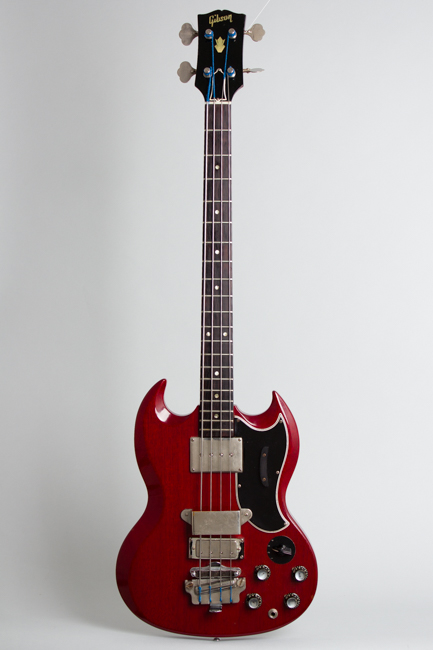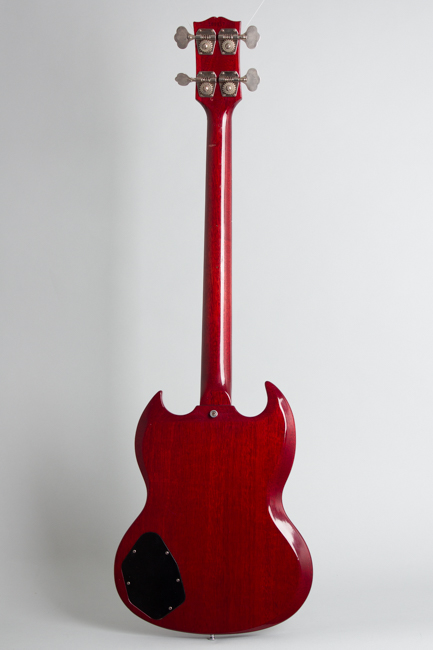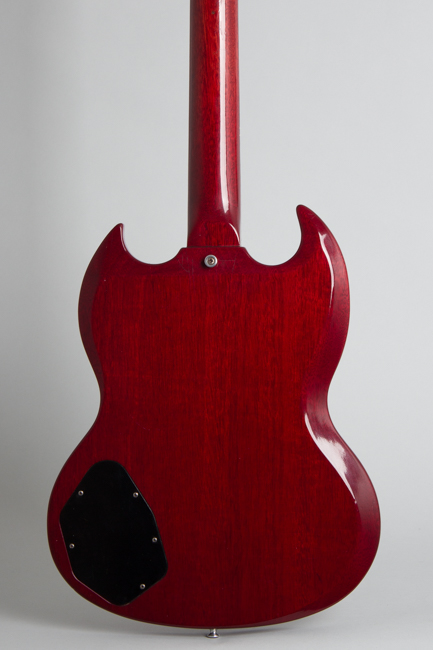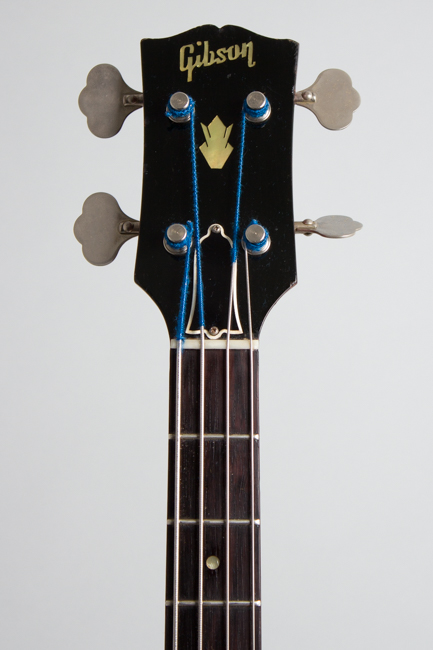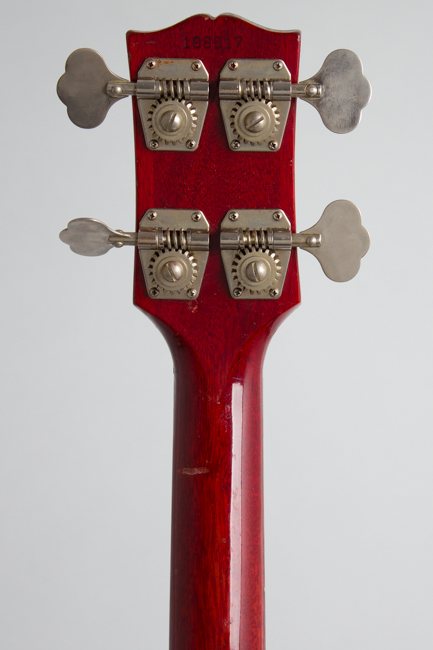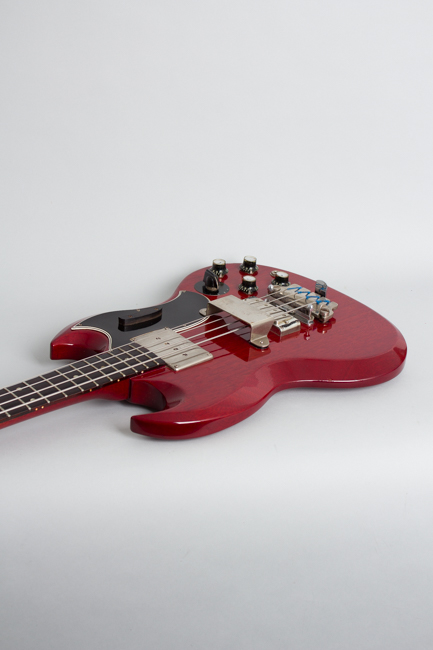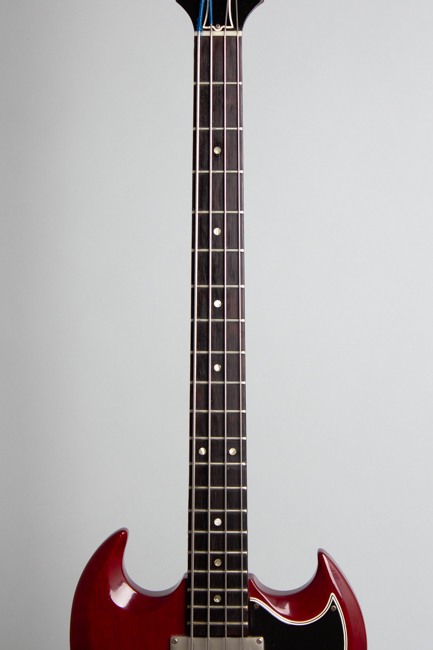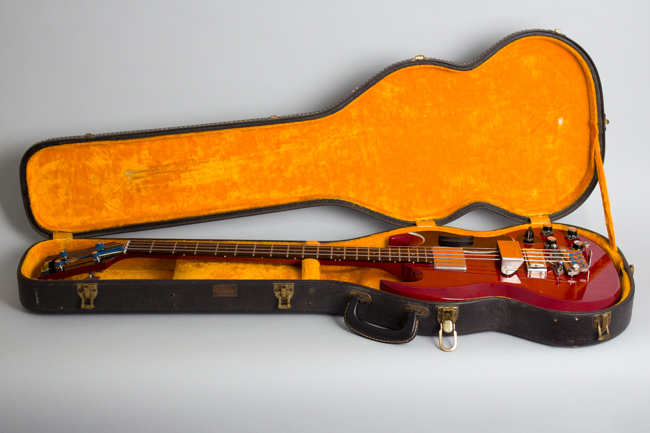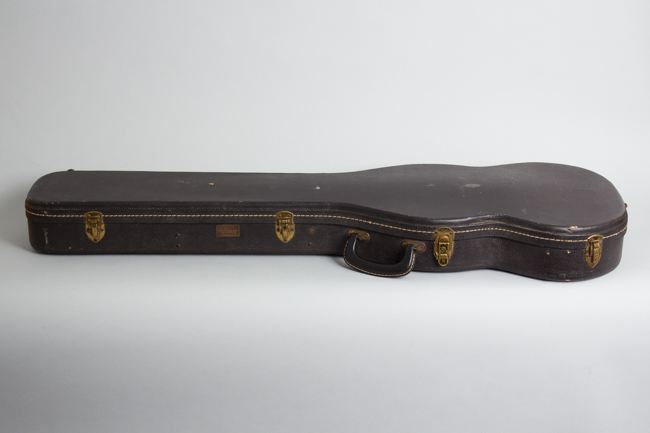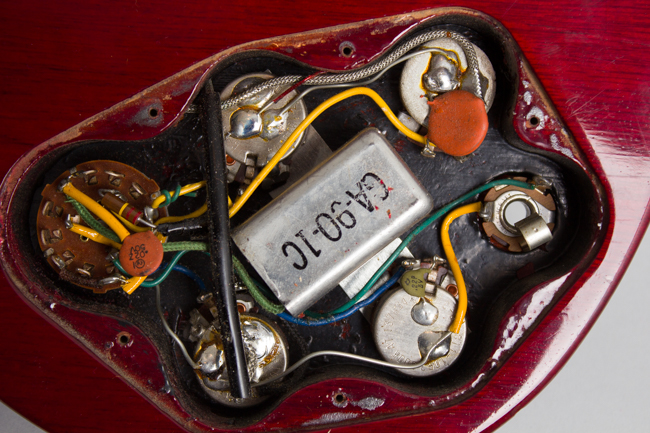Gibson EB-3 Solid Body Electric Bass Guitar (1964)
Gibson EB-3 Model Solid Body Electric Bass Guitar (1964), made in Kalamazoo, Michigan, serial # 198517, cherry lacquer finish, mahogany body and neck, rosewood fingerboard, original black hard shell case.
This is a beautiful example of the exactly correct "Cream Era" Gibson EB-3 bass, pretty much identical the primary one used extensively by Jack Bruce from 1966 into the mid-70s. These expensive double pickup EB basses were made in fairly small quantities from 1961 into the mid-1960s but most examples that surface now are the later '60s and early '70s models, when they were produced in much greater numbers -- at least partially due to the popularity of Cream! Those are fine instruments in their own right but have numerous differences from the "Bruce-spec" ones like this!
This is essentially the upmarket 4-string version of the SG model guitars with the same cherry-finished elaborately sculpted body and the squared-off neck pocket. Due to the tenon set deeper into the body the basses do not suffer the same neck heel issues as their 6-string cousins. This all-original '64 remains in excellent playing condition; even the original felt in the lever-action mute is intact.
The two humbucking pickups (large at the neck, small near the bridge) are controlled by a 4-way rotary selector, giving a much wider range of tone than the common EB-0 with just a single "Mudbucker" at the neck position. The control knobs are in the "wide spaced" configuration seen prior to 1965; that year the choke in the cavity was re-angled to create a spacing consistent with other Gibson models allowing use of a universal template for routing the control cavity instead of a specific one for this fairly low-production model.
The 30 1/2" scale neck is chunkier than later examples, with a noticeably wider nut than those made after mid-late 1965. While the early Gibson EB-3 has a certain classic status it is a fairly uncommon instrument; only 277 were shipped in 1964 compared to over 1100 of the single-pickup EB-0 that year alone. One reason is it was a very expensive instrument; the list price in September 1964 was $350 plus $72 for the deluxe hard shell case; that was considerably pricier than even a Custom-Color Fender Jazz Bass ($293.47) and just under Gibson's own long-scale Thunderbird IV ($370).
While it largely fell out of favor in the later '70s and '80s, this easy-to-play and very distinctive-sounding bass was used by a number of (mostly English) rock bassists in the 1960s and '70s, including Jack Bruce, Andy Fraser, Pete Quaife with the Kinks, Chris White with the Zombies, Rolling Stone Bill Wyman in the early '70s, Tom Evans of Badfinger, Glenn Cornick of Jethro Tull, Trevor Bolder with the Spiders from Mars, Jim Lea of Slade and many others. They appeared in the '60s with several San Francisco bands as well, including Big Brother and the Holding Company and the early Quicksilver Messenger Service. The EB-3's distinctive growl is one of the most recognizable electric bass tones on record.
Of course Bruce is the most famous EB-3 user, and much of the classic Cream output and his early solo work features the darkly aggressive sound of the Gibson at full throttle. His most identified personal instrument was made in 1965, likely just a few months after this one. While traditionally perhaps not to every players' taste, this style EB-3 is the only bass with the exact sound, look and feel for "homemade Cream"!
Overall length is 40 7/8 in. (103.8 cm.), 13 in. (33 cm.) wide at lower bout, and 1 1/4 in. (3.2 cm.) deep. Scale length is 30 1/2 in. (775 mm.). Width of nut is 1 11/16 in. (43 mm.)., 8.44 lbs.
This bass has been fairly lightly played over the last 60 years but not abused, and remains all original with no repairs or modifications. This is the nicest "Bruce-Spec" EB-3 we have had; the cherry finish retains a nice rich, dark hue, checked only slightly with only some light fading on the back of the neck. There are some small dings, dents and scrapes scattered around, with one finish chip off the lower front edge and a noticeably deep scrape down to the wood on the back of the neck behind the first fret. The back shows hardly any belt buckle wear. The finish along edges of the unbound fingerboard has some light wear and small dings, and the headstock edges have a few chips.
The instrument retains all the original fittings and hardware including the handrest and fully functional mute assembly. The pickguard is fully intact with no splits or popped corners. There is some light typical wear to the plating, especially to the chromed plastic treble pickup ring. The frets show hardly any wear and the fingerboard is quite clean. The bass has been almost certainly strung with flatwound strings through its entire existence, and an original 1960s set of light gauge flats are still on giving the exact correct Jack Bruce feel/
This is one of the most comfortable basses we have played; fairly light, supple and effortless to handle. The vintage flatwound strings are quite low tension and super easy on the fingers. The sonic options range from a big, seething tide of low-end darkness, ("All the bass all the time" as Geddy Lee put in in his excellent book of bass lore) to edgier growl to a tight thump all with the twist of the "chicken head" dial. This is a really superb example of this classic early '60s Gibson bass, still housed in the original $72 yellow lined deluxe shaped HSC. Overall Excellent - Condition.
This is a beautiful example of the exactly correct "Cream Era" Gibson EB-3 bass, pretty much identical the primary one used extensively by Jack Bruce from 1966 into the mid-70s. These expensive double pickup EB basses were made in fairly small quantities from 1961 into the mid-1960s but most examples that surface now are the later '60s and early '70s models, when they were produced in much greater numbers -- at least partially due to the popularity of Cream! Those are fine instruments in their own right but have numerous differences from the "Bruce-spec" ones like this!
This is essentially the upmarket 4-string version of the SG model guitars with the same cherry-finished elaborately sculpted body and the squared-off neck pocket. Due to the tenon set deeper into the body the basses do not suffer the same neck heel issues as their 6-string cousins. This all-original '64 remains in excellent playing condition; even the original felt in the lever-action mute is intact.
The two humbucking pickups (large at the neck, small near the bridge) are controlled by a 4-way rotary selector, giving a much wider range of tone than the common EB-0 with just a single "Mudbucker" at the neck position. The control knobs are in the "wide spaced" configuration seen prior to 1965; that year the choke in the cavity was re-angled to create a spacing consistent with other Gibson models allowing use of a universal template for routing the control cavity instead of a specific one for this fairly low-production model.
The 30 1/2" scale neck is chunkier than later examples, with a noticeably wider nut than those made after mid-late 1965. While the early Gibson EB-3 has a certain classic status it is a fairly uncommon instrument; only 277 were shipped in 1964 compared to over 1100 of the single-pickup EB-0 that year alone. One reason is it was a very expensive instrument; the list price in September 1964 was $350 plus $72 for the deluxe hard shell case; that was considerably pricier than even a Custom-Color Fender Jazz Bass ($293.47) and just under Gibson's own long-scale Thunderbird IV ($370).
While it largely fell out of favor in the later '70s and '80s, this easy-to-play and very distinctive-sounding bass was used by a number of (mostly English) rock bassists in the 1960s and '70s, including Jack Bruce, Andy Fraser, Pete Quaife with the Kinks, Chris White with the Zombies, Rolling Stone Bill Wyman in the early '70s, Tom Evans of Badfinger, Glenn Cornick of Jethro Tull, Trevor Bolder with the Spiders from Mars, Jim Lea of Slade and many others. They appeared in the '60s with several San Francisco bands as well, including Big Brother and the Holding Company and the early Quicksilver Messenger Service. The EB-3's distinctive growl is one of the most recognizable electric bass tones on record.
Of course Bruce is the most famous EB-3 user, and much of the classic Cream output and his early solo work features the darkly aggressive sound of the Gibson at full throttle. His most identified personal instrument was made in 1965, likely just a few months after this one. While traditionally perhaps not to every players' taste, this style EB-3 is the only bass with the exact sound, look and feel for "homemade Cream"!
Overall length is 40 7/8 in. (103.8 cm.), 13 in. (33 cm.) wide at lower bout, and 1 1/4 in. (3.2 cm.) deep. Scale length is 30 1/2 in. (775 mm.). Width of nut is 1 11/16 in. (43 mm.)., 8.44 lbs.
This bass has been fairly lightly played over the last 60 years but not abused, and remains all original with no repairs or modifications. This is the nicest "Bruce-Spec" EB-3 we have had; the cherry finish retains a nice rich, dark hue, checked only slightly with only some light fading on the back of the neck. There are some small dings, dents and scrapes scattered around, with one finish chip off the lower front edge and a noticeably deep scrape down to the wood on the back of the neck behind the first fret. The back shows hardly any belt buckle wear. The finish along edges of the unbound fingerboard has some light wear and small dings, and the headstock edges have a few chips.
The instrument retains all the original fittings and hardware including the handrest and fully functional mute assembly. The pickguard is fully intact with no splits or popped corners. There is some light typical wear to the plating, especially to the chromed plastic treble pickup ring. The frets show hardly any wear and the fingerboard is quite clean. The bass has been almost certainly strung with flatwound strings through its entire existence, and an original 1960s set of light gauge flats are still on giving the exact correct Jack Bruce feel/
This is one of the most comfortable basses we have played; fairly light, supple and effortless to handle. The vintage flatwound strings are quite low tension and super easy on the fingers. The sonic options range from a big, seething tide of low-end darkness, ("All the bass all the time" as Geddy Lee put in in his excellent book of bass lore) to edgier growl to a tight thump all with the twist of the "chicken head" dial. This is a really superb example of this classic early '60s Gibson bass, still housed in the original $72 yellow lined deluxe shaped HSC. Overall Excellent - Condition.
